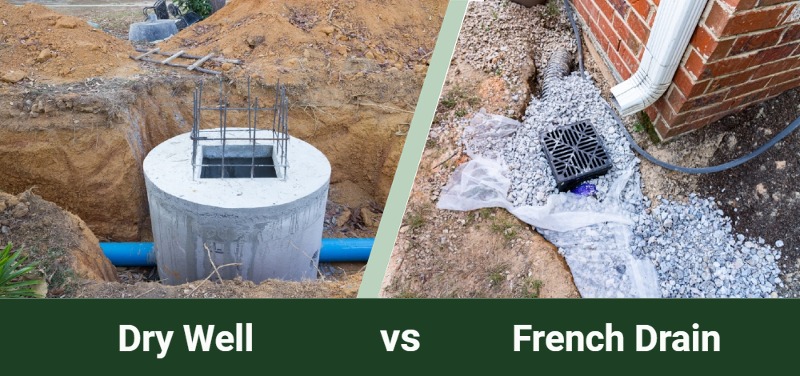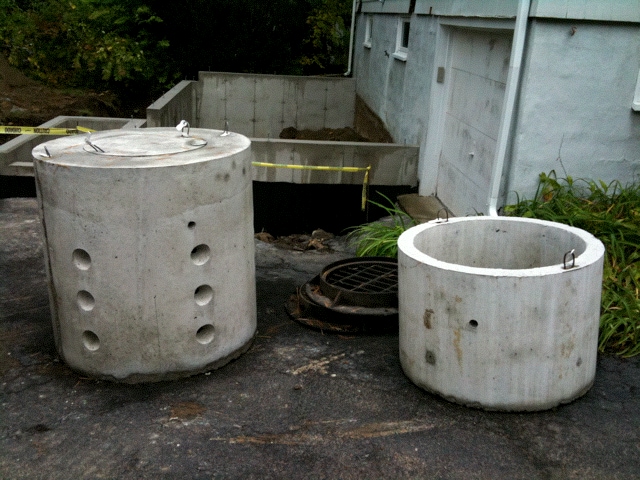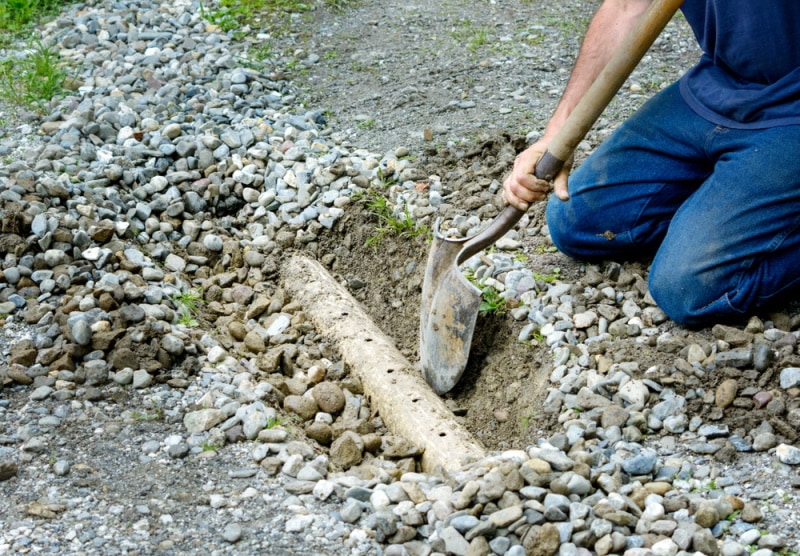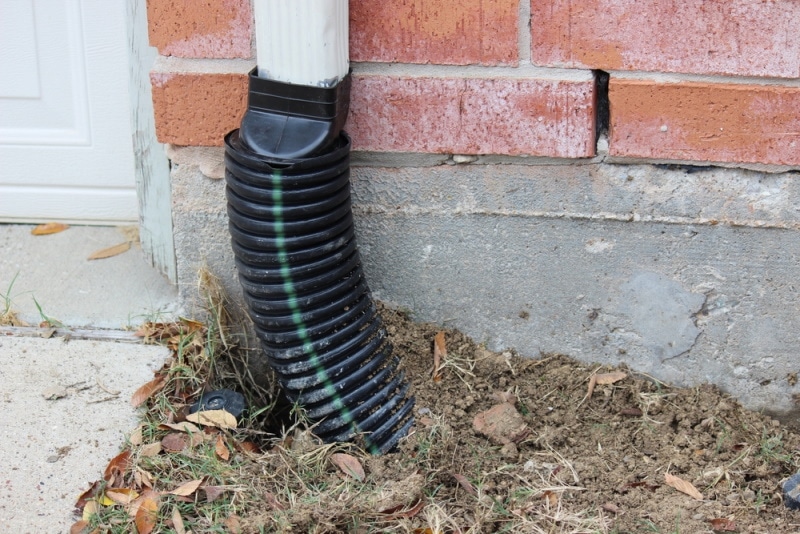Dry Well vs. French Drain: Differences Explained (With Pictures)
-
Pete Ortiz
- Last updated:

Since many people throughout the United States fight daily with excess water collecting on their property, a few draining systems help with flood control. The dry well and French drain are excellent examples of these systems that efficiently drain the water from your property and away to ponds, local water sources, or deep in the ground. These drainage systems have many advantages and disadvantages that make them different, so it is essential to know which system is the perfect one for you.
To learn all the features that make these draining systems differ, read the article below, as we’ve gathered the essential information you need to know.
Click Below to Jump Ahead:
Overview of the Dry Well

How it Works
Dry wells are underground chambers that help drain and collect unwanted water, such as rainfall or stormwater. Heavy rainfall tends to accumulate on a specific area of the property, causing flooding and, in more severe cases, erosion of the ground. Dry wells work as water displacement systems meant to transmit all water collecting on the surface directly to the underground. Dry wells are usually dug up 30 to 70 feet underground; on the surface, they are usually 3 feet wide. The inside walls of dry wells are usually lined with gravel, which slowly drains the water and filters into the soil without contaminating it.
What it’s Good For
Installing a dry well properly in a perfect location can significantly help drain excess water from your property. Due to heavy rainfall, water tends to collect in the lowest point in the yard, causing erosion and damage to the property. By installing a dry well in the lowest spot, the water will slowly collect and drain into the designated area, making your property much safer.
Dry wells have many environmental benefits, especially for managing stormwater runoff and preventing it from entering and polluting lakes and streams. Stormwater runoff, if not handled or appropriately drained, can also cause erosion and damage aquatic habitats. Dry wells can also have a significant impact on reducing the effects of drought by restoring groundwater levels.
What Are the Risks?
One common risk when dealing with a dry well is when the rainfall becomes too heavy for the dry well to handle. This water displacement system can become easily overwhelmed by storms and heavy rainfall and clogged due to branches and debris entering the dry well system. To prevent this, you can have your dry well cleaned regularly and cleared of debris. When a problem this severe happens, it can cause the flooding of your entire property, causing additional damage and repair costs.
Dry wells have been known as an effective way to drain stormwater by transferring it to underground water, although some risks can appear when the rainfall is contaminated. Dry wells are an excellent way to recharge the local groundwater supplies. Still, the groundwater can quickly become contaminated when certain substances or illegal surface spills find their way into the dry well. You can monitor this by correctly installing a dry well and using appropriate pretreatment.
- Controls the amount of water accumulated on the surface
- Reduces the risk of soil erosion and damage
- Promotes healthy plant growth
- Durable, versatile, and long-term solution
- Storms, heavy rainfall, and debris can overwhelm the dry well
- Installation can be expensive
- The stormwater runoff can contaminate the underground water
Overview of the French Drain

How it Works
The French draining system deals with excess water and melting snow by redirecting the flow away from your home. The French drain is installed in your property’s most problematic areas, where water often accumulates. In those specific places, trenches are dug up and filled with perforated pipes that are covered with multiple layers of gravel for better drainage and filtration. The water is then transferred to areas away from the property intended explicitly for storing water, such as a rain bucket or the municipal wastewater drain. The pipes need to be positioned at an optimal angle to provide the water with an unobstructed flow, preventing build-up and flooding.
What it’s Good For
The main benefit of installing a French drain in your yard is preventing the accumulation and pooling of excess water in one area instead leading the water away from the yard. This can significantly decrease the risk of flooded basements, weakening foundations, and cracking or soil erosion. Another excellent benefit, and a critical one, is that your home’s foundation and crawl space can stay dry, eliminating any potential damage. When installing a French drain, you can continue maintaining a perfect green lawn or garden with the prevention of suffocating your plants and vegetables.

What Are the Risks?
While a French drain is an incredibly practical system for draining water, there are some risks that you need to be aware of before installing this system in your backyard. The first thing you need to keep in mind is the location where you are installing the French drain and whether there are any power lines or communication lines buried beneath the ground. In certain states in the US, you are required to get permission from the authorities before making any changes to your property.
Another risk when installing a French drain is the possibility of heavy rainfall and debris clogging the underground pipes. These drains can quickly become jammed without warning, causing larger damage than before any draining was installed.
- Effective at moving the water away from the property
- Excellent at preventing flooding and water damage
- Appealing as they can easily be covered up with garden decor
- Energy-efficient and cost-effective
- Installing the system can be a frustrating and time-consuming process
- The system can sometimes become clogged, causing further damage
- Some existing structures may need to be removed to install a French drain
Which System Is Right for You?
When to Use a Dry Well?
Installing a dry well in your yard is the best solution when you want to drain water from your yard, but there are no nearby storm drains or ponds to redirect the water into. With a dry well, there doesn’t have to be any nearby water; instead, the water is directed deep into the ground.
When to Use a French Drain?
A French drain directs the excess stormwater to the river, pond, or nearby drainage area. Unlike the dry well, where water is directed deep underground, the French drain carries the water through the perforated pipe into an area where it drains.
Conclusion
After learning the different features and services these draining systems provide, you can hopefully decide which system is ideal for you. These systems benefit your entire property, as they can lower the risk of damage to your home’s foundation and prevent soil erosion. Installing them in your garden will require time and effort, but you can maintain a healthy lawn without frequent flooding.
Featured Image Credit: (L) bochimsang12, Shutterstock | (R) Stephen Reeves, Shutterstock
Contents



